IXODES FECIALIS Warburton & Nuttall
Ixodes fecialis Warburton and Nuttall, 1909, pp. 58-9,
figs. 1, 2; Nuttall and Warburton, 1911, pp. 248-9, fig. 245.
Nuttall, 1916, p. 327. Ferguson, 1925, p. 28. Fielding. 1926, p.
51, fig. 18. Taylor and hurray, 1946, pp. 56-7, fig. 56.
Ixodes fecialis var. aegrifossus Warburton and
Nuttall, 1909, pp. 56-60, fig. 3. Nuttall and Warburton, 1911, p.
250, fig. 246. Nuttall, 1916, p. 335.
Ixodes (Exopalpiger) fecialis Schulze, 1935, p. 37.
The larva of this species is unknown.
Male
Fig. 24, a-h
Diagnosis
A small, narrowly oval tick, with a very narrow, marginal body fold; capitulum short, palpi wide apart, basis with dorsal carinae; no cornua, no auriculae; dentition 2/2 of rounded teeth; scutum with numerous punctations; anal plate straight-sided, a little wider posteriorly than anteriorly, adanal plates rectangular; coxae unarmed with strongly developed, membranous outgrowths on posterior margin; tarsi tapering gradually.
Description
Body.-Narrowly oval and somewhat bluntly pointed posteriorly, twice as long as wide, 2.1 by 1.1 mm, and widest in region between coxae 11 and Ill ; marginal body fold very narrow, commencing near coxa II and widening a little posteriorly; hairs pale and decumbent.
Capitulum.-Short, 0.28 mm in length; basis dorsally hexagonal, 0.26 mm wide, median field depressed, finely granulated, lateral fields swollen and glossy and separated from median field by well-defined carinae which extend from the posterolateral angles convergently to base of mouthparts; posterior margin straight, no cornua; posterolateral margins straight and divergent anteriorly; palpi wide apart, article 1 rounded, a little wider than long, articles 2 and 3 fused, narrow at base but broadening rapidly, the apex rounded, 0.18 mm in length, and with a maximum width of 0.11 mm.
Hypostome short and broad, shorter than palpi, 0.14 mm.in length. sides parallel, apex rounded; dentition 2/2 of 5-6 rounded teeth.
Scutum.-Similar in shape to body, dimensions slightly smaller, bluntly pointed behind; punctations numerous; cervical grooves short, convergent; emargination moderate; scapulae bluntly pointed.
Genital aperture.-At level of coxa II.
Ventral plates.-Pregenital plate small, wider than long; median plate straightsided and hexagonal, widest at about two-thirds the length, 1.07 by 0.43 mm anal plate with anterior and lateral margins straight, a little wider posteriorly than anteriorly; adanal plates almost rectangular, the lateral sides almost straight.
Spiracular plate.-Somewhat egg-shaped, the narrower end posterior and the longer axis directed anteriorly, about 0.2l mm in length.
Legs.-Length moderate, comparatively stout; coxae unarmed and provided with strongly developed, membranous outgrowths on posterior margin; tarsi tapering gradually, tarsus I 0.37 in length, tarsus IV 0.40 mm in length.
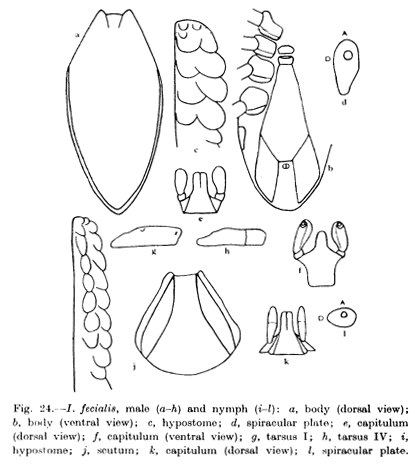
Fig. 24. 1. fecialis, male (a-h) and nymph (i-l): a, body (dorsal view); 6, body (ventral view); c, hypostome; d, spiracular plate; e, capitulum (dorsal view); f, capitulum (ventral view); g, tarsus I; h, tarsus IV; i, hypostome; j, scutum; k, capitulum (dorsal view); L, spiracular plats.
Female
Fig. 25, a-i
Diagnosis
Scutum longer than wide and widest towards the posterior margin, lateral carinae well developed; capitulum relatively slender and of moderate length, article 1 of palpi enlarged, strongly salient laterally, and fused diagonally with basis, basis dorsally usually with carinae, no cornua, porose areas oval and convergent anteriorly ; dentition 2/2; coxae unarmed and with well-developed membranous outgrowths on posterior margin; anal grooves subparallel or gently convergent behind.
Description
Body.-Unfed specimens elongate oval, 2' 1-2'3 mm by 1'0-1' 1 mm, widest in region of spiracles; marginal grooves complete and well defined; thickly clothed with pale, decumbent hairs; semi-engorged and engorged specimens, 5. 7-11' 7 min by 3' 7-7' 2 mm, the marginal groove gradually disappearing and the hairs becoming erect and scattered as engorgement proceeds; posterolateral and median grooves well developed.
Fig. 25. 1. fecialis, female: a, capitulum (dorsal view); 6, capitulum (ventral view); c, scutum; d, hypostome; e, anal grooves; f, coxae; g, tarsus I; la, tarsus IV; i, spiracular plate.
Capitulum. -Length 0.51-0.67 mm; basis dorsally hexagonal, 0.35-0.40 mm wide, the median field usually a little swollen and separated from the lateral fields by distinct carinae, otherwise median field flat and carinae ill defined or lacking; the posterior margin usually straight, no cornua, the posterolateral margins slightly curved, short, and divergent; basis ventrally in some specimens with similar carinae; porose areas moderate in size, oval, convergent anteriorly, sometimes not very distinct, the interval at its narrowest point about equal to the width of one; palpi flat, article 1 enlarged, triangular, inserted diagonally on basis with which is fused but line of fusion distinct, strongly salient laterally, articles 2 and 3 about 0.48 mm in length , article 2 narrow at base, broadening medianly, article 3 as broad as article 2 but not quite half as long.
Hypostome 0.25-0.36 mm in length, with parallel sides and rounded apex; dentition 2/2 of about 10 blunt teeth, the external teeth a little larger than the internal teeth.
Scutum.-Longer than wide, 1.2-1.4 min by 0.9-1.2 mm, widest towards the posterior margin; anterolateral margins straight, or- slightly sinuous, posterior angle very broad and rounded; lateral carinae well developed, straight or slightly sinuous, and a little convergent just prior to attaining the posterolateral margin; punctations sometimes few but usually numerous and fine with a few coarser areas, though sparse, laterally; cervical grooves represented anteriorly by short, shallow convergent finely granulated areas, sometimes more defined and subparallel posterior to mid-length; emargination moderate; scapulae bluntly pointed; some scattered, pale hairs.
Genital aperture.-At level of coxa III.
Genital grooves.-Divergent to posterior half of body, then curved and convergent; in engorged specimens they do not reach posterior margin of body
Anal grooves.-Rounded in front, then subparallel or slightly curved convergently behind, and becoming a little divergent posteriorly.
Spiracular plate.-Oval, the longer axis transverse. 0.29 by 0.33 mm.
Legs.-Slender and of moderate length; coxae unarmed, with membranous outgrowths on posterior margins; coxa I with well developed anterior projection. all coxae with a row of hairs about laid-length; tarsi slender and tapering gradually, tarsus I about 0.5 min in length, tarsus IV about 0.58 min in length.
Nymph
Fig. 24, i-l
Diagnosis
Body with many hairs, becoming scattered on engorgement; scutum as in female; basis capituli and palpi as in female; dentition 212; coxae and anal grooves as in female.
Description
Body.-Unfed specinien 1.4 by 0.9 min, engorged specimen 2.8 by 1.9 mm; body in unfed specimens oval, narrowly rounded posteriorly; many pale hair, becoming scattered on engorgement.
Capitulum.-Length about 0.33 mm; basis dorsally as in female with well defined carinae, surface granulated; palpi as in female. articles 2 and 3 0.3 mm in length, article 3 not quite as long as article 2.
Hypostome 0.17 mm in length, with a bluntly rounded apex; dentition 2/2, 1/1 basally, with 9-10 teeth, the external teeth larger than the internal teeth.
Scutum.-Measurements 0.66-0.70 mm by 0.60-0.64 mm; shape and lateral carinae as in female; punctations fine and not obvious, surface granulated; cervical grooves superficial posteriorly and attaining posterolateral margin; emargination relatively shallow; scapulae rounded.
Anal grooves.-as in female.
Spiracular plate.-Oval, the longer axis transverse, 0.10 by 0.14 mm.
Legs.-As in female; tarsus I 0.28 mm in length, tarsus IV 0.3 mm long.
Hosts and Distribution
Warburton and Nuttall (1909) described this species from the western native cat, Dasyurinus geoffroyii, Cranbrook, W.A., March 1910, and recorded as other hosts under I. fecialis aegrifossus, Isoodon obesulus, Bannister, W.A., 21.viii.1900, and "opossum", Tamborine, Qld., June 1907. Nuttall (1916) added Dasyurus quoll (= D. viverrinus), 21.i.1912 and 4.vii.1912, and Rattus rattus, both records being from Sydney. Taylor and Murray (1946) included Mus sp., Western Australia.
Material examined.--QUEENSLAND: Antechinus favipes, Dalveen, 26.vi.1951, 1 male, 1 female; Rattus assimilis, Mt. Glorious, 1 o; R. conatus, Mt. Glorious, 1 o; I. obesulus, Brisbane, 2 oo; "wallaby", Deception Bay, 5 females; Felis catus, Brisbane, 15.iii.1951, 1 female; R. calmorum, Benarkin, 22.x.1953, 3 oo; Perameles sp., Eidsvold, 1.vii.1890, 1 female. NEW SOUTH WALES: R. assimilis, Colo Vale, 1 o. TASMANIA: "tiger cat", Arthur R., 13.v.1951, 1 female; Antechinus sp., McIntyre R., 1 female, 1 o. WESTERN AUSTRALIA: D. geoffroyii, Mahogany Creek, 1 o; I. obesulus, Mahogany Creek, 2 females, D. geoffroyii, Kendenup, 15.i.1929, 2 females, 2 oo; Myrmecobius fasciatus, Tackalarap, 2 oo; Sminthopsis crassicaudata, Ravensthorpe, 1 female.
Comments
Warburton and Nuttall (1909) refer to the shape of the basis as "with winglike projections hollowed dorsolaterally to receive the palps." These wing-like projections are the lateral extensions of palpal article 1, which is fused with the basis, although the line of fusion is distinct.
The male is described for the first time, the description being based on a single specimen. This sex is a very small tick closely resembling I. antechinus in shape, but is a little larger with differences in the basis capituli, the shape of the ventral plates, and in coxa I which bears a small external spur in I. antechinus.
The nymph has also not been previously described in any detail. It was seen by Nuttall (1916) who noted that it "closely resembled the female".
The shape of palpal article 1 and of the scutum with its lateral carinae readily distinguish the female.
The following ticks were taken from a rat in Wollongong, Nov 2000. The gross morphology resembles Ixodes fecialis but this has not been confirmed by microscopic examination. A nymph tick was also found. The rat was moribund.
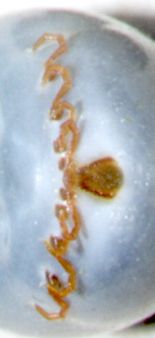
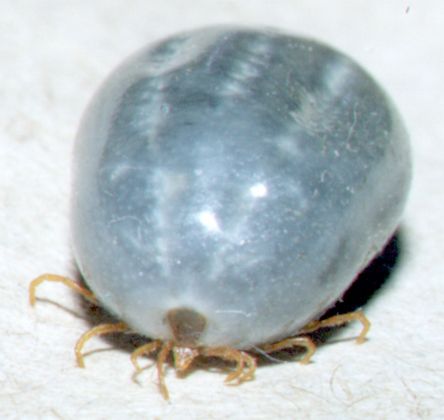
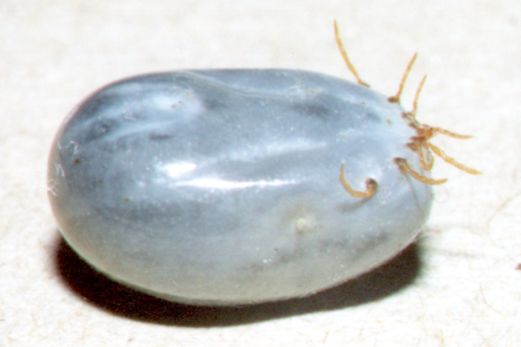
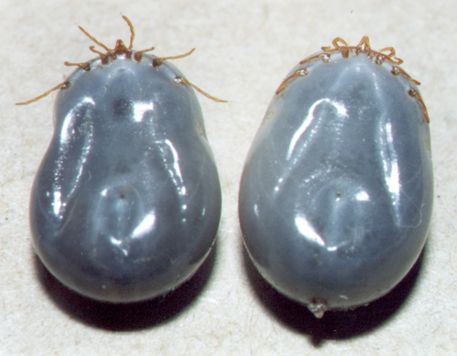
The Paralysis Tick of Australia - Home
E-mail Us to report a broken link!